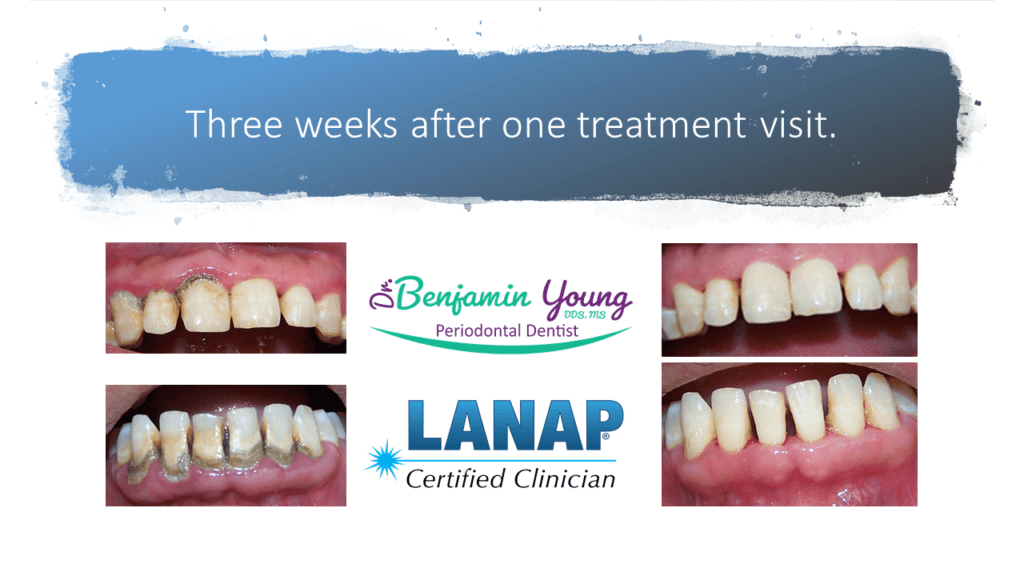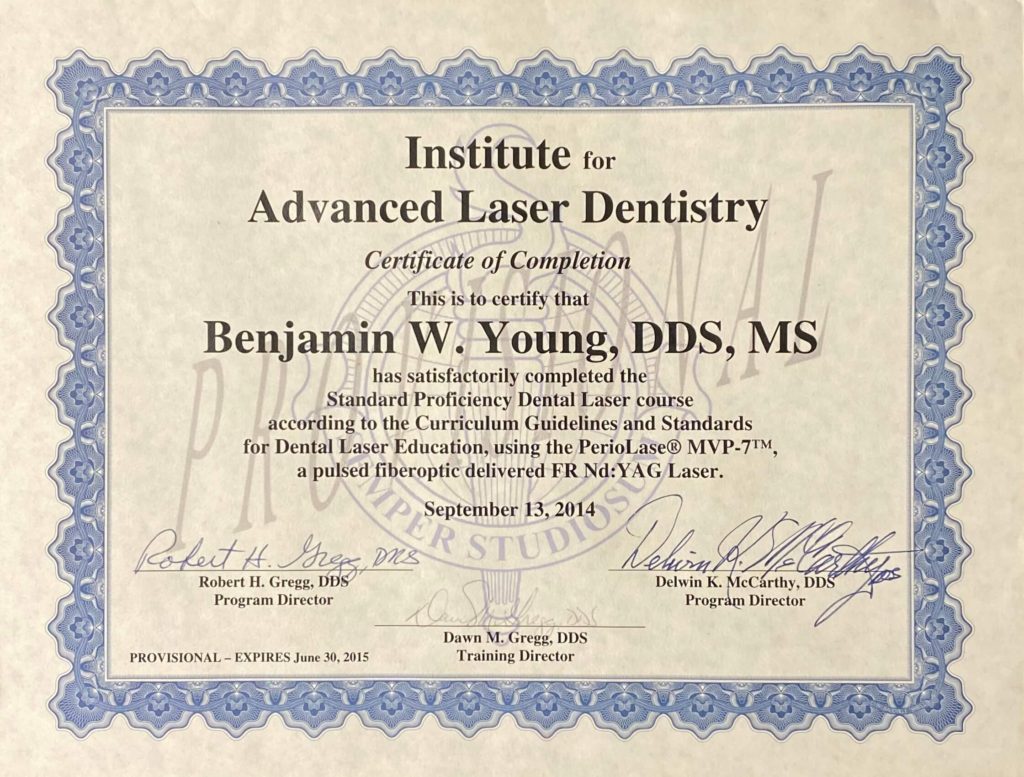LANAP® LASER ASSISTED NEW ATTACHMENT PROCEDURE
LANAP also goes by another term “Laser Assisted Regeneration (LAR).” These are the FDA-cleared laser treatment that offers a less painful, more successful treatment alternative to conventional surgery.
LANAP is the only scientifically, research-proven methodology that results in true periodontal regeneration, new bone growth, and gum tissue reattachment. LANAP is accomplished with the PerioLase MVP-7. It is a free-running, variable pulsed Nd: YAG laser. The 7 variable pulse durations can be thought of as “different lasers” in one device, each having a discrete and discriminating tissue interaction important for providing the best clinical results.
The LANAP or LAR treatment is one of the most successful protocols in treating periodontal disease today because it can target the source of the inflammation without hurting or removing any healthy gum tissue. It can slow or stop attachment loss and decrease pocket depth. And best yet, it enables the body to recover from deep-seated chronic infection without the need for a scalpel or sutures.
For over three years I attempted to submit this procedure with the existing and only insurance codes available to me, and what I found was that insurance companies would routinely deny coverage. Some would send back a statement that laser is “experimental.” This is an excuse and frankly untrue – as evidenced by the fact that it is the only FDA-approved procedure I’m aware of in dentistry. Placement of dental implants is not FDA approved, for example – and I’m not saying it needs to be, but what I am saying is that there was enough evidence for the Food and Drug Administration to approve the LANAP approach to treating periodontal disease.
And why was this FDA approval sought?
Because systems are entrenched redundant bureaucracies and research through universities often run extremely slow. The upside to institutions being slow and deliberate is public protection. The downside to slow and deliberate is that new and better approaches can be overlooked, sometimes for decades.
So lasers are no longer experimental, but some insurance companies have not changed their policies for twenty years and don’t plan to. And what is so interesting to me in all of this is that the LANAP procedure resolves periodontitis faster and at a lower cost which would result in a healthier general population. Perhaps, insurance companies calculate that more patients who would not go through classic periodontal therapy would seek this approach and this would result in them paying out more in care. Keep in mind, the insurance company is happy when treatment is difficult and slow because there is a high likelihood that patients will not go through care and therefore will not use the insurance money.



FAQs
1. Conventional Care. The first phase is non-surgical therapy. This is scaling and root planing and involves the scaling off of tartar or calculus and then the smoothing of the root surface. The anticipated pocket depth improvement is within the range of 2 mm. LANAP is a completely different approach to therapy and is generally not Dr. Young’s approach to treating this disease. There are exceptions based on certain circumstances, but when LANAP is a viable option, it is Dr. Young’s preferred method of care for all the reasons described here. The second phase is surgical therapy. This can involve a number of different procedures depending on the specific problems of a particular area.
Conventional Care works but in general requires more appointments compared with LANAP. However, LANAP may not be enough either in specific areas and so surgical therapy involving exposing bony defects and suturing may be necessary.
2. No treatment. This is a poor choice and problems once begun can progress over time.
This is a difficult question to answer outright because we need to first know what specific problems are. Usually the cost for a comprehensive examination without any insurance coverage is under $200. But let’s put this in perspective. If someone has avoided dental care for a period of time, how much money would they have spent had they simply seen a dentists annually for check ups and periodically, as recommended , for cleanings? Think about this money now being used for the treatment of conditions now. Also, the earlier problems are addressed, the less expensive treatment will be. Personally, I would rather know specifically what things will cost rather than speculate. If you want to know more and you have dental insurance, there is probably a fee schedule you can access to see costs of periodontal care.
You live at a time in world history where we have local anesthetics and methods to help people manage their fears that are simple and predictable. Also the level of tenderness following procedures in this area of dentistry are effectively managed without the need for narcotic pain medications. So, no. Treatment should not be painful.
Your initial visit will be about an hour of your time. During that visit we will provide you with a full periodontal exam, diagnosis, and treatment plan. Following this, especially if we will be using laser gum disease treatment, it will take as few as two additional appointments and no more than an additional four hours of time before you are back to seeing your general dentist and dental hygienist for continuing supportive periodontal care going forward. If you have not watched my explanation about managing periodontal disease I recommend you do so.
Watch “A Tooth Has Four Parts” to find out. It will take fifteen minutes of your time.


